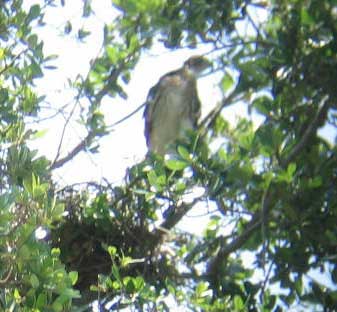|
June 23
This morning I hurried out to see if young Slats was hopping about in the live oak tree. There was no sign of him. A single downy baby hawk feather drifted down out of the tree. Where is little Slats?
Late in the afternoon, Jay and I took our binoculars and went searching for Slats. We didn’t have to go very far! There were Slats and Henrietta, both perched on the side of the nest. Slats is now almost as large as Henrietta. While we watched, Rufous did a fly-by, pursued by a couple of screeching mockingbirds. “What’s wrong with this picture?” I mused. Rufous should be chasing them! Rufous flew north, across the street, to a willow tree on the greenbelt. Watching him through the binoculars, we soon understood. He was squeezing the life out of a small bird, undoubtedly one of the mockingbirds’ youngsters. Rufous busily plucked the feathers from his catch, occasionally calling a single “kek,” then swooped over to his nest to bring dinner to his chick. Soon, we saw only a baby hawk bottom and stubby tail feathers, as Slats chowed down on the mockingbird.
June 24
Young Slats was standing tall and proud on the side of the nest this morning. Except for the fuzz of down still clinging to his head and body, he looks like a fully grown hawk. Neighbor Sean and his pit bull puppy Katana came over to take a look. Sean confessed that he had tried numerous times to see the hawks, but couldn’t spot their nest. And it’s true that there is only one vantage point where the hawk nest can be seen. Sean took a look through my binoculars, and was amazed at the size of the almost-grown hawk chick.
June 27
The heat in Valley Ranch is palpable and oppressive, with temperatures reaching 103° in the afternoon. The hawk nest seems to shimmer in waves of summer sun, and throbbing cicadas vibrate from every tree. Jay and I cannot find young Slats, but we have seen him every day this week. What must such merciless heat be like for a juvenile hawk? He has no siblings to divert his attention, and waits patiently for Henrietta or Rufous to bring his food.
We wonder why there is only one little hawk, and not the "three to five" that Coopers hawks usually raise. Perhaps it is because Henrietta is a young hawk. Perhaps the grackles interrupted the hawk pair’s mating at a crucial time. Perhaps the gale force winds and torrential rains that pounded the hawk nest took the lives of some of the chicks. We will never know. But we do know that Slats is the strong survivor, and he has had no competition for food.
June 28

"Toddler" Slats,
perched above the nest.
|
This morning, Slats is clinging tenaciously to a small branch directly over the nest, no doubt waiting for breakfast. His back is dark grey-brown, more like Rufous than Henrietta. His breast and leggings are white. Faint buff-colored markings have appeared on his breast. His eyes are bright, round, and yellow, and he moves his head to follow the noises below him. He still has the slightly scruffy appearance of a fledgling bird, and his tail feathers are stubby and short, but an edge of white at the tip of his tail is apparent. He frequently spreads his wings and moves about in the tree, always close to the safety of the nest. Jay asked me how I know Slats is a male bird. Well, I don’t! And we may never know. I have a history of mistaking the sex of kittens, so how would I know about a baby hawk? |
Today was another scorcher. It was almost dark when I went out one last time to check on Slats. Henrietta was perched beside the nest, but Slats was nowhere to be seen. Then I heard a plaintive little cry in a neighboring live oak tree. “Peee-yuuu!” And Henrietta answered, “Kek!” She stood her ground by the nest until it was dark, and I gave them up for the night. Slats is moving around in the trees now. The branches of the two live oaks intertwine, so he has lots to explore. He will remain close to the nest, however, as long as there are free meals. I have read that Coopers hawks feed their young for up to eight weeks, so we may be able to see Slats for a couple more weeks before he decides to take off on his own.
Continue to Chapter 12: The Fledgling Hawk
[TABLE OF CONTENTS]
|